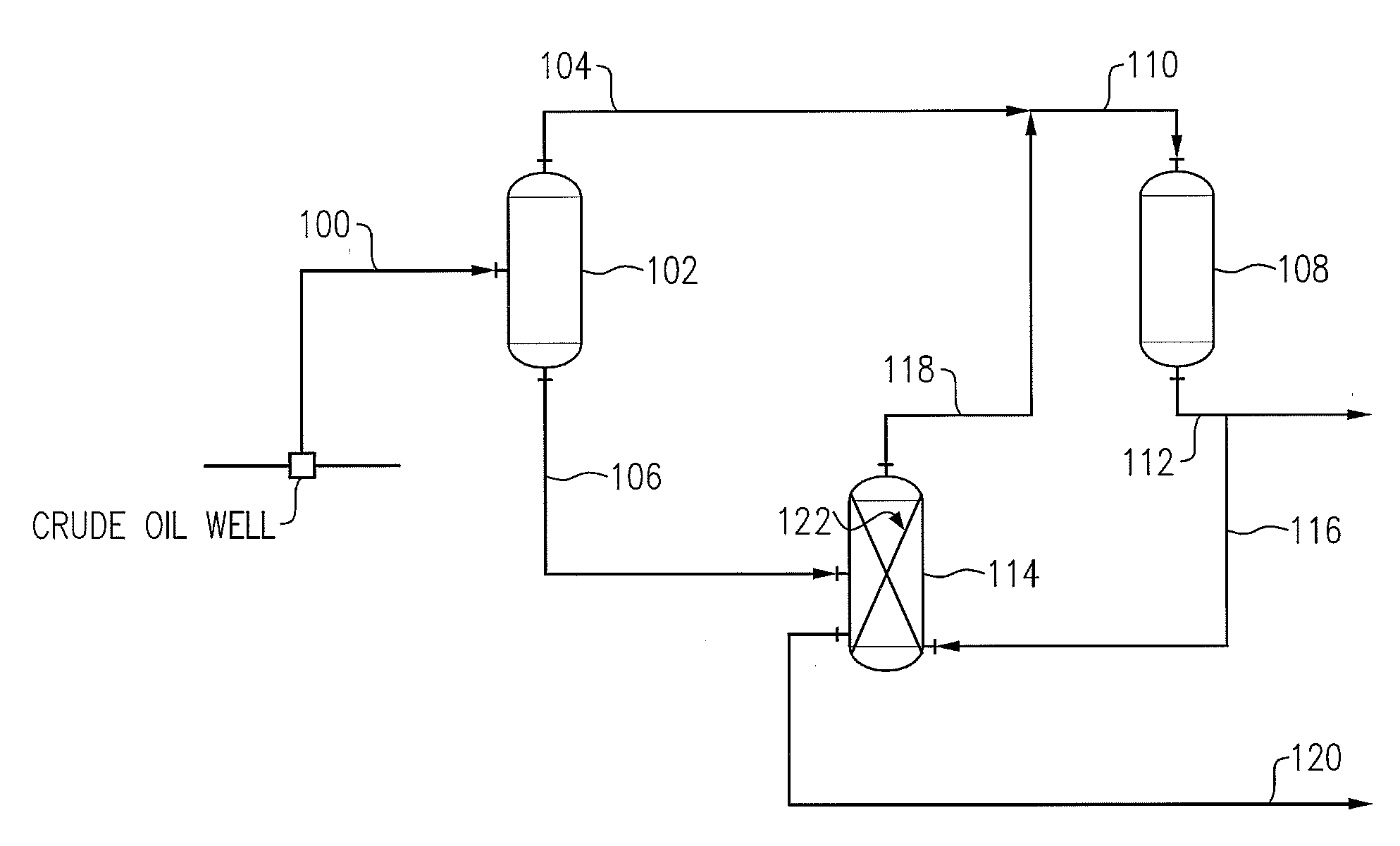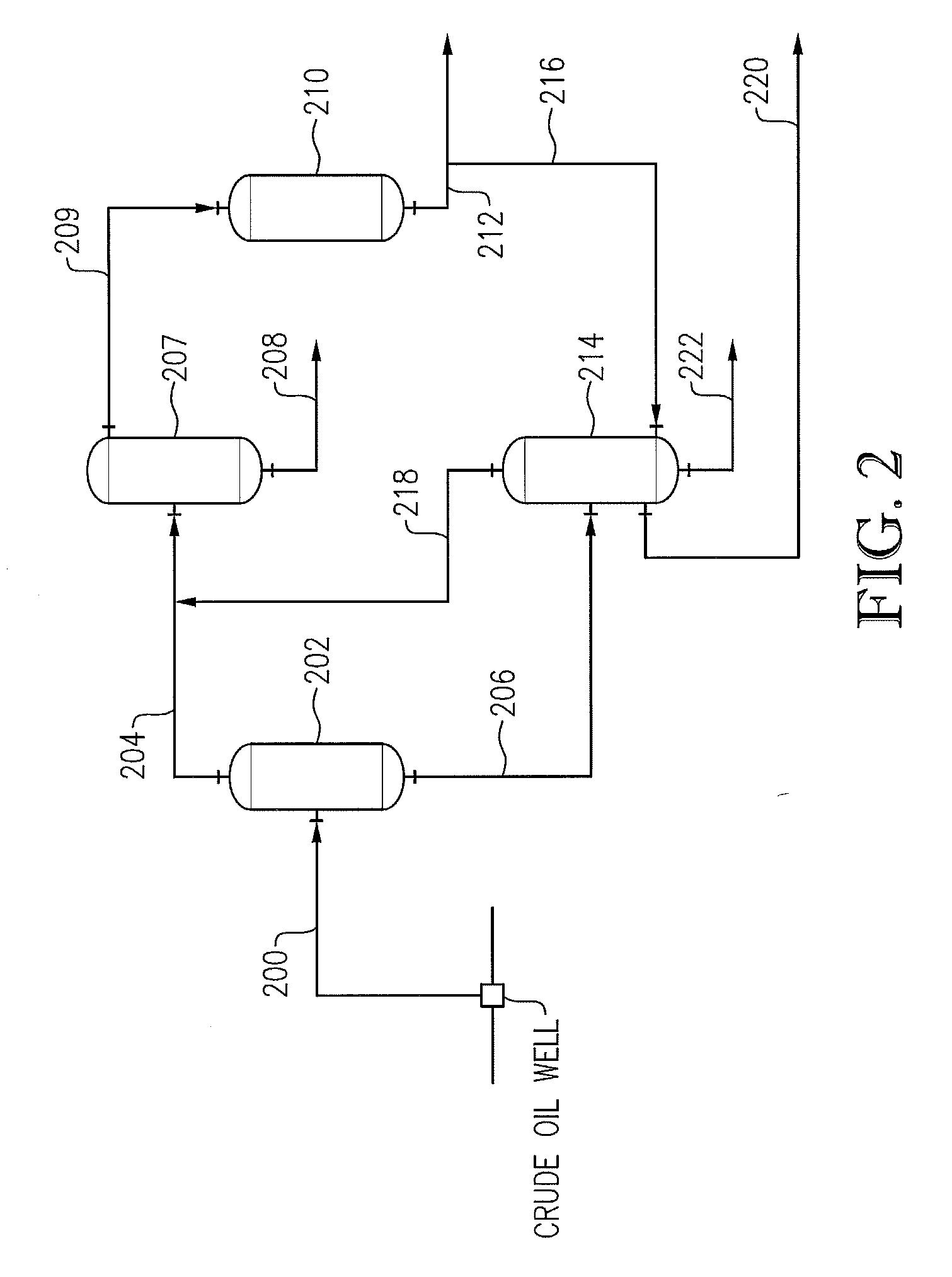Mercury removal from crude oil
a crude oil and mercury technology, applied in the field of crude oil mercury removal process, can solve problems such as health and environmental problems, downstream processing units, and metal processing
- Summary
- Abstract
- Description
- Claims
- Application Information
AI Technical Summary
Problems solved by technology
Method used
Image
Examples
example 1
[0028]A simulation of the liquid / gas contactor was constructed using an equation of state thermodynamic prediction model for mercury partitioning between gas and liquid using data for elemental mercury in a naturally obtained crude oil blend. Results of the calculation are shown in FIG. 3, wherein the temperature of the crude oil is plotted against the pressure to achieve 90% removal of mercury from the liquid oil feed to the contactor. A gas to oil ratio of 80 SCF / bbl was used in the model.
[0029]Common pressure of a Low Pressure Coalescer / Separator present at the well site (which is redeployed as set forth herein as a gas / oil contactor) ranges from about <1 to ˜3 Bars. In typical applications, reservoir temperature of high mercury crude oils is greater than about 150° C. This simulation thus shows that 90% mercury removal is achievable at the temperature and pressure conditions often present at the crude oil well site.
example 2
[0030]An experiment was run to test the removal of elemental mercury (Hg) from a hydrocarbon by sparging with a lighter hydrocarbon. The elemental mercury was dissolved in decane at about 1,300 ppbw. FIG. 4 shows the results of the experiment, plotting residual Hg in the decane versus liters of methane sparged through the decane for two different runs, Runs 1 and 2.
[0031]A third experiment (Run 3) was performed wherein, prior to adding the elemental mercury, the decane was water washed and passed over a silica gel column to remove trace levels of chloride, oxide or sulfur compounds that could, at the conditions of the experiment, oxidize the mercury and cause it to form non-spargable mercury compounds. Also shown in FIG. 4 is a plot of the results of theoretical calculations of the mercury removal process. The plot shows that the experimental results for Runs 1 and 2 are in good agreement with the theoretical calculations and that the experimental results for Run 3 are in excellent ...
example 3
[0032]A simulation was run in order to evaluate affect of the number of theoretical stages (e.g., as indicated by reference number 122 in FIG. 1) on mercury removal. Various vapor / liquid (V / L) molar ratios of gas to hydrocarbon liquid were used in the simulations (0.295, 0.147 and 0.074). Results of the model are shown in FIG. 6 and demonstrate that for all V / L molar ratios increasing the number of theoretical stages results in increased mercury removal. For instance, increasing the number of theoretical stages from 1 to 5 increased the mercury removal by a factor of four.
PUM
| Property | Measurement | Unit |
|---|---|---|
| weight percent | aaaaa | aaaaa |
| temperature | aaaaa | aaaaa |
| temperature | aaaaa | aaaaa |
Abstract
Description
Claims
Application Information
 Login to View More
Login to View More - R&D
- Intellectual Property
- Life Sciences
- Materials
- Tech Scout
- Unparalleled Data Quality
- Higher Quality Content
- 60% Fewer Hallucinations
Browse by: Latest US Patents, China's latest patents, Technical Efficacy Thesaurus, Application Domain, Technology Topic, Popular Technical Reports.
© 2025 PatSnap. All rights reserved.Legal|Privacy policy|Modern Slavery Act Transparency Statement|Sitemap|About US| Contact US: help@patsnap.com



